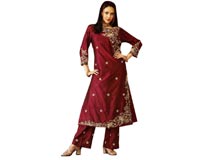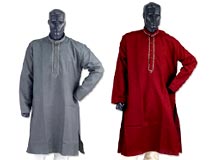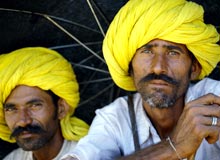
In
India, one can spot many men wearing turban. Well, turban is tied not
for the sake of fashion, but because it has a lot of significance in the
lives of Indians. The hair turban is a headdress that basically consists
of a long piece of unstitched cloth, which is wrapped around the head.
The hair turban used in India is usually 5 meters in length. Each time,
the wrapping is unfolded and tied all over again.
The turban more commonly known as pagri was initially tied to keep the
head cool. It was actually a way to escape from the blazing heat or to
put succinctly a means to beat the scorching heat of sun. To cope with
the hot climatic conditions of desert, this long piece of cloth was
soaked in water overnight and then tied in the morning. The different
layers of turban kept wet throughout the day and thus provided a great
relief.
From region to region, the style of turban draping differs. Out of all
the turbans, Rajasthani and Sikh turbans are especially popular. People
in the Middle East, Central Asia and South Asia are known for tying
turbans. Modern turbans come in varied sizes, colors and shapes. In the
western countries, the turban serves as the hat for women. These turbans
are mostly stitched so that they can be easily worn and taken off.
Popular Turbans
Sikh Turban
Well, turban has a lot of reverence and significance in the Sikh
religion. People who join the Khalsa Panth are forbidden to cut their
hair. Sikh men wear turban so as to manage their long hair. In the Sikh
religion, the turban is known as dastar, which is considered to be a
very respectful Punjabi word.
Rajasthani Turbans
Rajasthan is a very big state exhibiting a wide diversity. In
Rajasthan, as you travel from one city to another, you'll find men
wearing absolutely different turbans. In Rajasthan, the turban is known
as pagri or safa. There are certain parts in Rajasthan, where the size
of turban is evocative to the position and status of the person in
society.
Mysori Turbans
In the districts of Kodagu and Mysore, turban is known as Mysore peta.
Here, the is considered to be a source of pride. Notable personalities
are honored by presenting them the Mysore peta. This in itself is
suggestive of the fact as to how much significance the turban has for
the people in Mysore. In the district of Kodagu, men team their ethnic
dress with a turban on the celebration of special occasions.
Turbans in Muslim Community
In Islamic religion, wearing turban is considered customary. Muslims
call turban "imamah". Most of the scholars in Muslim countries
wear turban. Thus, it is considered an important headdress amongst the
Muslims. Infact, even the men of honor and other eminent persons in the
Muslim community wear turbans.
 In
India, one can spot many men wearing turban. Well, turban is tied not
for the sake of fashion, but because it has a lot of significance in the
lives of Indians. The hair turban is a headdress that basically consists
of a long piece of unstitched cloth, which is wrapped around the head.
The hair turban used in India is usually 5 meters in length. Each time,
the wrapping is unfolded and tied all over again.
In
India, one can spot many men wearing turban. Well, turban is tied not
for the sake of fashion, but because it has a lot of significance in the
lives of Indians. The hair turban is a headdress that basically consists
of a long piece of unstitched cloth, which is wrapped around the head.
The hair turban used in India is usually 5 meters in length. Each time,
the wrapping is unfolded and tied all over again.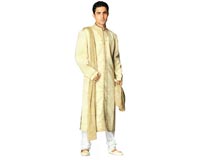 Sherwani
is a long coat resembling achkan in styling. It is buttoned upto the
collar and lengthwise it is usually below the knee. It adds to the charm
and grace of men, especially the taller ones. Indian men spend lavishly
on buying the sherwani suit for the special occasion of their wedding.
This traditional clothing for Indian men is witnessing mushrooming
growth in its demand. In India, men don Sherwani over the Kurta and
Churidar pajama. As a part of fashion, Sherwani is sometimes teamed with
Kurta and salwar. To know more about traditional sherwanis in India,
read on.
Sherwani
is a long coat resembling achkan in styling. It is buttoned upto the
collar and lengthwise it is usually below the knee. It adds to the charm
and grace of men, especially the taller ones. Indian men spend lavishly
on buying the sherwani suit for the special occasion of their wedding.
This traditional clothing for Indian men is witnessing mushrooming
growth in its demand. In India, men don Sherwani over the Kurta and
Churidar pajama. As a part of fashion, Sherwani is sometimes teamed with
Kurta and salwar. To know more about traditional sherwanis in India,
read on.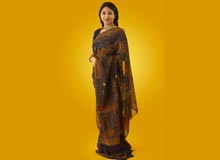 Sari
is one of the most wonderful dresses worn by Indian women. Infact, when
one thinks of a typical Indian woman, the first thing that strikes the
mind is a woman clad in sari, who is wearing the solah shringar
including bindi, chudi, kajal and many more. Apart from highlighting the
characteristic image of an Indian woman, the Indian dress saree also
adds grace to a woman's personality. To know as to how as wear a Sari,
read on.
Sari
is one of the most wonderful dresses worn by Indian women. Infact, when
one thinks of a typical Indian woman, the first thing that strikes the
mind is a woman clad in sari, who is wearing the solah shringar
including bindi, chudi, kajal and many more. Apart from highlighting the
characteristic image of an Indian woman, the Indian dress saree also
adds grace to a woman's personality. To know as to how as wear a Sari,
read on.